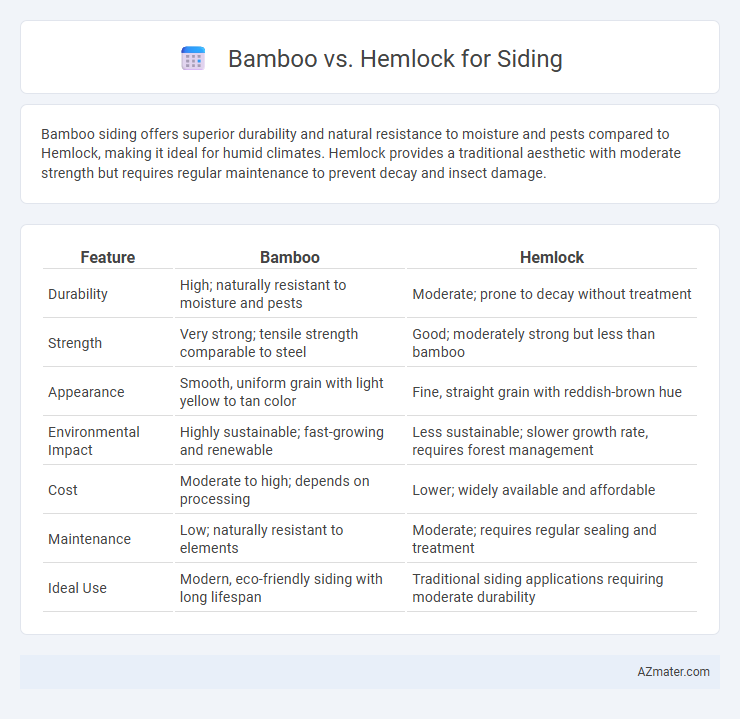Bamboo siding offers superior durability and natural resistance to moisture and pests compared to Hemlock, making it ideal for humid climates. Hemlock provides a traditional aesthetic with moderate strength but requires regular maintenance to prevent decay and insect damage.
Table of Comparison
| Feature | Bamboo | Hemlock |
|---|---|---|
| Durability | High; naturally resistant to moisture and pests | Moderate; prone to decay without treatment |
| Strength | Very strong; tensile strength comparable to steel | Good; moderately strong but less than bamboo |
| Appearance | Smooth, uniform grain with light yellow to tan color | Fine, straight grain with reddish-brown hue |
| Environmental Impact | Highly sustainable; fast-growing and renewable | Less sustainable; slower growth rate, requires forest management |
| Cost | Moderate to high; depends on processing | Lower; widely available and affordable |
| Maintenance | Low; naturally resistant to elements | Moderate; requires regular sealing and treatment |
| Ideal Use | Modern, eco-friendly siding with long lifespan | Traditional siding applications requiring moderate durability |
Introduction to Bamboo and Hemlock as Siding Materials
Bamboo and hemlock are popular siding materials valued for their durability and aesthetic appeal in exterior design. Bamboo offers exceptional strength, natural resistance to moisture, and rapid renewability, making it a sustainable choice for eco-friendly siding projects. Hemlock features a straight grain, fine texture, and moderate durability, providing a traditional wood appearance with good weather resistance when properly treated.
Environmental Impact: Bamboo vs Hemlock
Bamboo siding offers a significantly lower environmental impact compared to hemlock, as bamboo is a rapidly renewable resource that can be harvested every 3 to 5 years, whereas hemlock trees require decades to mature. Bamboo cultivation also sequesters more carbon dioxide and promotes soil health without the need for pesticides or fertilizers, contrasting with the slower growth and higher resource consumption of hemlock. Choosing bamboo siding supports sustainable forestry practices and reduces deforestation, making it an eco-friendly alternative to traditional hemlock wood.
Durability and Longevity Comparison
Bamboo siding offers impressive durability due to its natural resistance to insects and moisture, with a lifespan of 20 to 25 years when properly treated. Western Hemlock, a softwood commonly used for siding, typically lasts around 15 to 20 years but requires regular maintenance and sealing to prevent rot and insect damage. Bamboo's dense fiber structure and faster renewability make it a more sustainable and longer-lasting option compared to Hemlock in exterior applications.
Installation Process and Ease
Bamboo siding offers a lightweight and flexible material that simplifies cutting and fastening, allowing quicker installation with standard tools, while its natural resilience reduces the need for additional treatments. Hemlock siding, being a softwood, is moderately easy to work with but requires more care during handling due to its tendency to splinter and may need pre-drilling for nails or screws to prevent wood damage. Both materials demand surface preparation and proper moisture barriers, but bamboo's uniform density generally provides a smoother and faster installation experience compared to the variable hardness of hemlock.
Cost Analysis: Bamboo vs Hemlock Siding
Bamboo siding is generally more cost-effective than hemlock, with prices ranging from $3 to $7 per square foot, making it an affordable choice for sustainable building projects. Hemlock siding, costing between $4 and $9 per square foot, tends to be pricier due to its durability and traditional wood aesthetic. When factoring in long-term maintenance, bamboo's resistance to moisture and pests can result in lower upkeep costs compared to hemlock, which may require regular sealing and treatments.
Maintenance Requirements and Upkeep
Bamboo siding demands minimal maintenance due to its natural resistance to pests and moisture, requiring occasional sealing to preserve durability and appearance. Hemlock siding, while aesthetically appealing, needs regular staining or painting to protect against weathering, insect infestation, and rot. Proper upkeep of either material extends lifespan, but bamboo offers a more eco-friendly and low-maintenance solution for long-term exterior siding.
Aesthetic Differences and Design Flexibility
Bamboo siding offers a sleek, contemporary look with natural variations in color and grain that create a warm, organic aesthetic, ideal for modern or eco-friendly designs. Hemlock siding provides a more traditional, uniform appearance with a fine, straight grain and light reddish-brown hue, lending itself well to classic or rustic architectural styles. Bamboo's flexibility allows for various panel shapes and finishes, while hemlock's dimensional stability supports intricate woodwork and consistent staining.
Weather Resistance and Performance
Bamboo siding offers excellent weather resistance due to its natural density and high silica content, providing durability against moisture, insects, and rot, making it suitable for humid and rainy climates. Hemlock siding, while aesthetically appealing and strong, is more susceptible to moisture damage and requires regular sealing and maintenance to prevent warping and decay in wet conditions. Bamboo's superior performance in terms of longevity and resistance to environmental factors often makes it a more reliable choice for siding in diverse weather environments.
Sustainability and Eco-Friendliness
Bamboo siding offers superior sustainability due to its rapid growth rate, maturing in 3-5 years, which significantly reduces environmental impact compared to hemlock, which takes decades to mature. Bamboo's carbon sequestration capacity is higher, helping lower carbon footprints, while hemlock harvesting can contribute to deforestation and habitat disruption. Both materials are biodegradable, but bamboo's renewability and lower water requirements make it a more eco-friendly choice for siding applications.
Final Verdict: Choosing the Right Siding Material
Bamboo offers exceptional sustainability and rapid renewability, making it an eco-friendly choice for siding, with natural resistance to pests and moisture when properly treated. Hemlock provides a traditional wood aesthetic, durability, and excellent insulating properties but requires regular maintenance to prevent rot and insect damage. Choosing between bamboo and hemlock depends on prioritizing environmental impact and low maintenance versus classic wood appeal and proven longevity.

Infographic: Bamboo vs Hemlock for Siding
 azmater.com
azmater.com